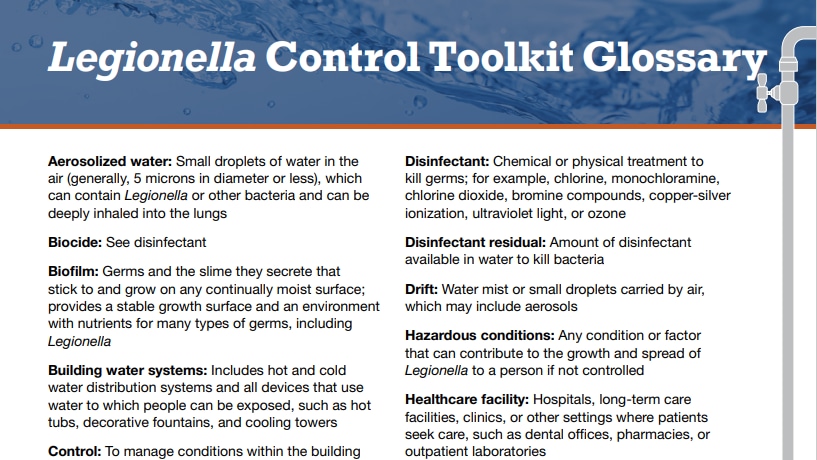Key points
- Below are a number of terms, phrases, and definitions used in the Legionella Control Toolkit.
- The Legionella Control Toolkit provides concise, actionable information on controlling Legionella in commonly implicated sources of Legionnaires' disease outbreaks.

A through C
Aerosolized water
Small droplets of water in the air (generally, 5 microns in diameter or less) that can
- Contain Legionella or other bacteria
- Be inhaled deeply into the lungs
Biocide
See Disinfectant
Biofilm
Germs and the slime they secrete that stick to and grow on any continually moist surface
Biofilm provides
- A stable growth surface
- An environment with nutrients for many germs, including Legionella
Building water systems
Includes hot- and cold-water distribution systems and all devices that use water to which people can be exposed, such as
- Hot tubs
- Decorative fountains
- Cooling towers
Control
To manage conditions within the building according to a water management program or to maintain established criteria
Control limits
Acceptable levels for the control measures being monitored to reduce risk for Legionella growth and spread
Can include:
- Maximum value
- Minimum value
- Range of values
Control measures
Actions that enable maintenance of control limits
Actions that can be taken for building water systems to limit growth and spread of Legionella, such as
- Heating
- Adding disinfectant
- Cleaning
Control points
Locations in water systems where a control measure can be applied
Corrective action
Actions taken to reestablish control when monitoring values or measurements are outside control limits
D through L
Dead legs
Piping subject to low or no flow because of design or decreased water use; for example, capped pipes or unused faucets
Disinfectant
Chemical or physical treatment to kill germs
Examples include
- Bromine compounds
- Chlorine
- Chlorine dioxide
- Copper-silver ionization
- Monochloramine
- Ozone
- Ultraviolet light
Disinfectant residual
Amount of disinfectant available in water to kill bacteria
Drift
Water mist or small droplets carried by air, which may include aerosols
Hazardous conditions
Any condition or factor that can contribute to the growth and spread of Legionella to a person if not controlled
Healthcare facility
Hospitals, long-term care facilities, clinics, or other settings where patients seek care, such as dental offices, pharmacies, or outpatient laboratories
Legionella
Bacteria that can cause Legionnaires' disease
Legionnaires' disease
A serious type of pneumonia (lung infection) caused by Legionella
M through R
Make-up water
Water provided to a device to replace system water lost through evaporation, processing, or draining
Non-potable water
Water not intended for people to drink or ingest
Examples include water for
- Industrial processes
- Irrigation
- Equipment (like cooling towers)
Non-routine Legionella testing
Testing for Legionella to investigate potential sources of environmental exposure for persons with disease
Note: Testing for public health investigations should always be performed in conjunction with the public health authority having jurisdiction
People at increased risk for Legionnaires' disease
Includes people 50 years or older, current or former smokers, and people with
- A chronic lung disease (like emphysema)
- A weak immune system due to illness or medicine
- Cancer
- Underlying illnesses
- Diabetes
- Kidney failure
- Liver failure
- Diabetes
Potable water
Hot or cold water intended for people to drink or ingest, such as for
- Drinking
- Bathing
- Food preparation
- Dishwashing
Remediation
Response activities taken to eliminate colonization in response to
- Control measures that persistently exceed control limits
- Events that pose an immediate risk to control
Required whenever Legionnaires' disease occurs
May also be appropriate for unexpected events such as equipment failure or acts of nature that disrupt the water system
Residual
See Disinfectant residual
Routine Legionella testing
Testing for Legionella to
- Establish a baseline measurement for performance indicators
- Validate a water management program or corrective action
Methods and objectives vary from those of non-routine Legionella testing
S through Z
Sediment and scale
Mineral build-up in a water system that uses up disinfectant and supports growth or survival of bacteria
Stagnation
When water does not flow well
Areas of stagnation encourage
- Biofilm growth
- Ambient temperatures
- Disinfectant residual reduction
Supplemental disinfection
Adding disinfectant to a water system on site
May require permitting for potable water systems
Validation
Activities to confirm the water management program is working as intended and is effective for Legionella control
Testing for Legionella is one method for validation of a water management program
Verification
Activities to confirm the water management program procedures are occurring as intended
Reviewing temperature logs to ensure temperature measurement occurred at the intended frequency is one verification method
Water age
Amount of time it takes for water to reach a point of use or fixture/device from the point of entry
Example: Slow moving water has a higher water age than water moving quickly through a building water system
Water management program (WMP)
Multistep process to reduce Legionella growth and spread that includes
- Establishing a team
- Describing building water systems
- Identifying areas or devices with a Legionella risk
- Determining and monitoring control measures
- Establishing ways to intervene when control limits aren't met
- Ensuring the program is running as designed and is effective
- Documenting all program activities
